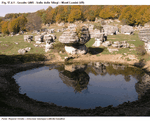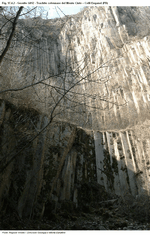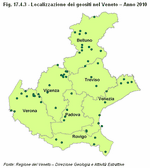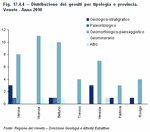(Note 1) The network of Sites of Special Scientific Interest (SSSIs) in Veneto is part of a national plan to promote better understanding and appreciation of Italy's geological patrimony, which has recently been the focus of an interesting scientific debate on a national and European level in which Italy's regions and its Institute for Environmental Protection and Research (ISPRA) under the Geological Patrimony and Geodiversity Project have played a fundamental role. This debate has led to numerous indications regarding how to conserve and promote sites of scientific interest.
A site, or geosito in Italian, is considered a SSSI if it characterises the geodiversity of a given territory including geological, geomorphologic, hydrological and paleontological characteristics, which are sometimes determining factors in conserving the integrity of ecosystems.
Regione Veneto has adopted Wimbledon's (1995) definition of geological sites as areas or territories where it is possible to identify a geological or geomorphological interest for their conservation and protection.
Therefore, SSSIs are areas that because of their specific characteristics merit protection with the double aim of safeguarding and protecting them from human activities that might jeopardise the characteristics or very existence of the sites and of promoting these areas for tourist and educational purposes
(Figure 17.4.1).
Regione Veneto decided not to adopt a strictly geological definition of SSSIs since the main aim of these protected areas is to promote understanding and appreciation of the geological elements that surround us and to transmit the idea that even elements such as rocks, the particular shape of a landscape, and mining areas where fossils are found, though apparently not significant, are actually worth safeguarding and protecting. Clearly, however, included in this definition are geological sites that have scientific importance and are worth protecting, such as important stratigraphic and chronostratigraphic sites, the surfacing of rock strata, fossil deposits, etc.
The importance of SSSIs depends on how representative they are, how rare they are and the scenic-aesthetic value they offer. Whether or not they are representative depends on the degree to which the geological site is similar to the ideal model by considering its unique characteristics (lithostratographic, geomorphologic, geological-structural, etc.) and how typical it is of a certain area (e.g. the morphological characteristics of the Dolomites in the Bellunese area are typical of Alpine regions and have recently been declared world heritage by UNESCO). How rare a particular site is depends on the repetitiveness or distribution of the category the SSSI belongs to. The scenic-aesthetic value of a site depends on its beauty and ability to evoke emotions. In the end, site representativeness is the most important criteria in determining whether or not it should be part of the list of regional SSSIs or not.
To date, Veneto has 61 SSSIs and several dozens more are waiting to be evaluated in order to be part of the official list. The decision regarding which sites should be part of this list is guaranteed by studies, research and planning. A specific form is filled out including the information indicated on a national level by ISPRA, which includes descriptions of the main geological, environmental and territorial characteristics together with photographs and geographical specifications. Furthermore, other unique characteristics of a given area need to be indicated in the form, such as what limitations exist and how the site can be exploited
(Figure 17.4.2).
There are basically five types of sites in the Veneto region; the distinction depends on the specific interest the site promotes, i.e. geological-stratigraphic, paleontological, geomorphologic, landscape, geological mining, or other areas such as marine geology, hydrology, etc.
The SSSIs in the Veneto region are distributed rather regularly throughout its seven provinces. The provinces with the highest number of geological sites are Belluno, Verona and Vicenza; then come Venezia, Rovigo, Treviso and Padova. Most of the geological sites are located in the mountains or hills in the region. Only 19 sites are located on the plains, in the provinces of Venezia and Rovigo, and to a larger degree, in the provinces of Verona, Padova and Treviso
(Figure 17.4.3).
The majority of the sites have geomorphologic importance, i.e. landscape (47 sites), followed by those of geological-stratigraphic importance. The sites regarding palaeontology that, as of today, are recognised, are the fossil deposits in Pesciara di Bolca in the province of Verona and the dinosaur footprints found in Monte Pelmetto located near Cortina d'Ampezzo. The mining geological sites identified in the region include the Val Imperina mine near Agordo and the marble mine in Zovencedo in the province of Vicenza
(Note 2) (Figure 17.4.4).








